Hermès Un Jardin sur le Toit (2011): Two Manners of Jean-Claude Ellena Fuse into Vegetal Fireworks {Perfume Review} {New Fragrance}
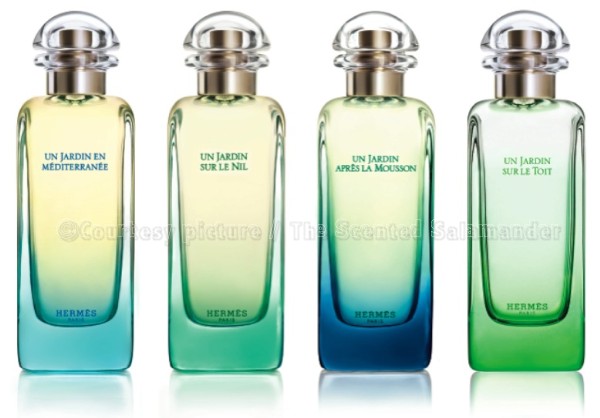
Un Jardin sur le Toit (A Roof-Top Garden) is the latest opus in the Jardin collection by Hermès. It might be the last one according to perfumer Jean-Claude Ellena who has expressed qualms about the more commercial orientation the collection is taking.
The penultimate "jardin-parfum", Un Jardin après la Mousson personally strikes me as a perfumer's study of accords. Perhaps then Ellena means his having had to supervise the creation of functional products derived from the collection like the All-Over Sprays. The full wardrobe now comprises four perfumes including the first, Un Jardin en Méditerranée, and the second one, Un Jardin sur le Nil.
Usually inspired by exotic locales or at least a change of scenery seen from the perspective of Paris being the epicenter of it all happening (I am thinking of Un Jardin en Méditerranée), the upcoming new garden scent entitled Un Jardin sur le Toit is this time about a familiar place: an urban garden, the roof-top garden of the Hermès headquarters overlooking the Faubourg Saint-Honoré, at number 24...
The new perfume, possibly due to the self-confessed pressure of the commercial success of the collection, illustrates to my nose a synthesis of Ellena's style, what one might see as a coming-together of his old manner and his new manner.
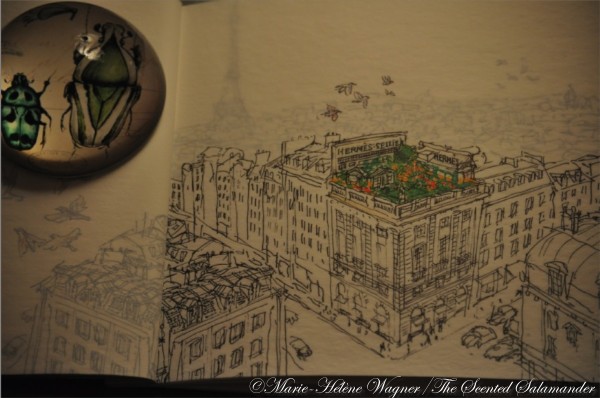 All the drawings of the Hermès garden and Un Jardin sur le Toit are by Philippe Dumas, the grand-son of Emile Hermès. The draughtsman has known it since his childhood.
All the drawings of the Hermès garden and Un Jardin sur le Toit are by Philippe Dumas, the grand-son of Emile Hermès. The draughtsman has known it since his childhood.
I find the composition of Un Jardin sur le Toit to be particularly intricate,
and less self-referential than what the new manner of Jean-Claude Ellena since Eau Parfumée au Thé Vert de Bulgari has accustomed us to expect. One gets a sense that we are less in the perfumer's workshop, looking over his shoulder to look at his accords, as invited to feel the simple joy of smelling and wearing perfume. I want to insist on the distinction existing between a perfume to be smelled and a perfume to be worn because Ellena is one of those perfumers that make you think that he is playing with the limits of these two genres, a tension he usually resolves with better-than-skin musky drydowns.Those Ambroxan-laden final touches are like apologies for being overly ascetic or on the contrary reminders of more essential things when the composition tilts towards wider appeal; the musky drydowns of the perfumer are like wax seals on his correspondence.
There is therefore the sensation here of a synthesis between his old manner, which used to be much more opulent and historically referential (see First by Van Cleef & Arpels and Rumba by Balenciaga, for instance), and his new manner which is usually spare privileging the style of the study or even at times the unfinished feeling of a sketch as for Eau Claire des Merveilles. With Un Jardin sur le Toit, I encounter the feeling not so much of smelling an olfactory Haiku like with Iris Ukiyoé - his latest Hermessence creation - as perceiving a scent which is still modernistic and simple but also rich and gem-like, all of this interestingly enough without conveying any sense of tension or contradictions nor inconsistencies. This might point to a new stage of maturing of the art of the perfumer rather than to a compromise.
I was surprised to see that external references seem to crowd the scent much more than is usual for the in-house perfumer of Hermès who usually eschews - in the period of his new manner at least - this kind of traditional insertion in the history of perfume thanks in part to his trademark economy of purpose. A contrario, for his perfume First by Van Cleef and Arpels, the nose said that he had put everything he knew about perfumery.
One can discern nonetheless in the details given about the background story of Un Jardin sur le Toit that Hermès had an explicit marketing strategy in that they were looking for an idea that would catch the competition off-guard.
One of the challenges of creative perfumery today is arguably that it has become such child's play to copy fragrance concepts and perfume formulae at high velocity,
thanks to both the internet and sophisticated perfume technology. Perfumery is particularly vulnerable to blitzkrieg plagiarism because while it requires intellectual and imaginative efforts to produce a novel perfume, it still is mostly thought of as a traditional recipe, a formula one can twist around like a food recipe found on the back of a package.
One of the ways in which a brand which devotes part of its energy and financial investment to being creative can try to do is to lock down and impress the novelty of the idea visually and conceptually onto the media. In this sense, Hermès with Un Jardin sur le Toit does succeed in making us understand that indeed this is something of a first. Un Jardin sur le Toit is not only about the scent of a Parisian garden, but that of an unusual roof-top garden and even more exclusively, that of Hermès' private garden. It becomes hard to copy the concept. Everything will be replicable except the unique olfactory imprint of Hermès headquarters garden. But Un Jardin sur le Toit is not just about a headspace capture of the garden, it is about the idea of the meaning of the garden and this is apparent in the gourmand interpretation and historical parallels one finds in the perfume. Also apparent is this classic trick of using an expensive material to help lock down the scent's signature.
Gabrielle Chanel famously encouraged the perfumer of the no.5, Ernest Beaux to amp up the use of precious rose and jasmine from Grasse so as to undercut the anticipated copycat pulsions of the competition. This is the old-fashioned way: use very expensive materials that not everyone can afford or access.
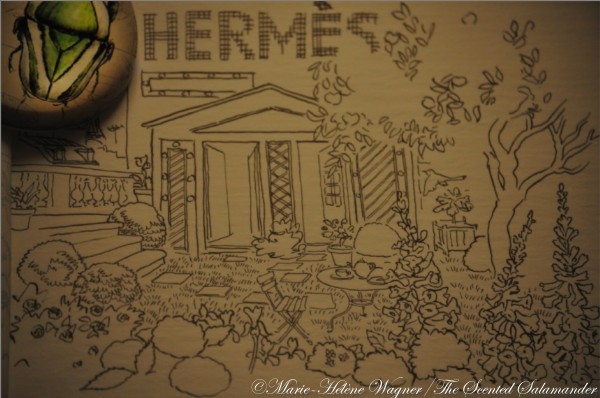 Some of the ofactory notes as found in the Hermès garden: stones, paevement, Normandy soil, apple tree, sage, roses, reseda, touch-me-nots, hawthorne, Paris air, dead leaves, box tree, crocuses, hibiscus, magnolia, rosemary, lilac, tulips, pears.
Some of the ofactory notes as found in the Hermès garden: stones, paevement, Normandy soil, apple tree, sage, roses, reseda, touch-me-nots, hawthorne, Paris air, dead leaves, box tree, crocuses, hibiscus, magnolia, rosemary, lilac, tulips, pears.
Un Jardin sur le Toit opens on an absolutely delicious medley of floral and fruity scents in which a succulent note of perfumed apple dominates,
The apple scent is on the green side mingling with the fresh notes of crisp, stemmy tulips. On a more conscious level, it feels like one of the best uses of Melonal both bringing shape to a sweet apple and contributing to a vaguer sense of sparkling cornucopia. There is the risk, especially in French culture where the scent of green apple is famously tied to at least two popular brands of shampoo, Dop and Yves Rocher, that there will be a reductionist approach expressed here by people stating that it smells like botted shampoo, but I really do not think so. The reason is that despite the frank note of green apple, the overal impression feels too finely chiseled, multifaceted and precious -- more like a taspestry than a towel. It feels to me like experiencing vegetal fireworks, explosive and celebratory of spring. Jean-Claude Ellena said that he added luminosity to the perfume to represent the City of Lights.
I wish to interject a note about the fact that perfumes nowadays are often criticized for smelling like shampoo. The truth of the matter is that nature itself sometimes does smell like shampoo. A flowering bush in a garden can suddenly make you realize that the more indistinct medley of scents found in a bottle of shampoo has been faithfully copied by perfumers to create the "shampoo accord" typical of spring air.
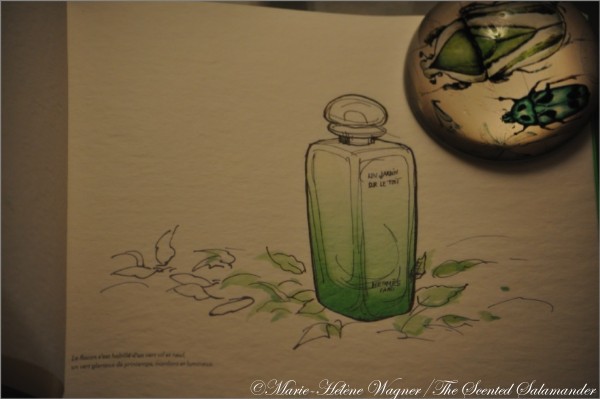
The fragrance while offering a distinct personality feels also familiar, in an unplaceable way at first as is often the case when you experience a perfume for the first time. The reptilian brain has been awakened but is not capable of being very articulate. I just know that this has nothing to do with the scent of apple itself. As my thoughts are further shaped by the scent, I am now reminded less confusedly of an accord found in a Frapin fragrance smelling of wet, fibrous cedar wood and peach vine, with an effect of floralcy. I think I am thinking about Esprit de Fleurs by Frapin.
There is an earthiness - a suggestion of the scent of fresh soil - about Un Jardin sur le Toit, mixed with gentler notes of light floral peach and pear which is reminiscent of the vintner charm of Frapin. But it might simply be that beyond this reference, the composition captures the scent of a particular mix of notes found in a French garden in Normandy transplanted to the roof of the Paris headquarters for Hermès. The house replanted apple, pear and magnolia trees from the Nomandy region right after World War II. During the war, this private garden was used as a victory kitchen-garden.
After a while, the familiar sensation calls to mind, of all perfumes, Angel by Thierry Mugler, in a very refined yet traceable way. There is the kindred, very characteristic sensation of a good-enough-to-nibble-on, edible, pastry-like patchouli accord where the caramel was replaced by pears presented on sappy green leaves.
The gourmand-fragrance lineage even more subtly traces back to Femme de Rochas with its stewed-prune accord,
Ellena is a great admirer and self-proclaimed disciple of perfumer Edmond Roudnitska who created Femme. The latter was ambivalent about his creation at times, feeling an urge to take his distances from gourmet notes which he tended to see as "easy." Created during World War II, Femme's prune note, I realize today, might have been inspired by wartime privations, a sense of hunger, the desire to eat delicious jams when they had become scarce or near impossible to find. Un Jardin sur le Toit offers the same historical thematic of wartime dream of cornucopia abundance since the garden was created during the war to overcome food shortages. It therefore offers a deeply coherent gourmand quality but lightened by osmanthus and other refined notes, like ambrette.
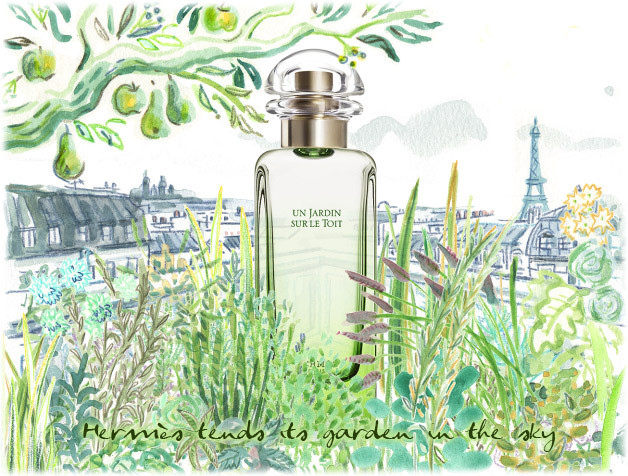
In the case of Un Jardin sur le Toit, the protective role that a costly material can have is based on an overdose of ambrette or musk seed, one of the costliest fragrance materials that can be had. Chanel have showcased it in the No.18 in Les Exclusifs collection because they can and because it is a material which suggests refinement like few others. Perfumer Jean-Claude Ellena used the pear-liquor facet of ambrette seed to suggest the pear trees of the roof top garden. Ambrette seed is one of the most luxurious notes in the perfumer's palette. It is a bit iris-y, fruity, pear-like, with a nuance of white wine, but also musky and skin-like. It is a refined, delicate material. The ambrette seed, mingling with the scent of fresh carrot, a nuance not found in No. 18 by Chanel, nevertheless reminds you of the same ambrette overdose. A hint of powderiness suggests baby powder.
Finally, as the perfume dries down, it confirms to me its gem-like, precious personality as Un Jardin sur le Toit ends up smelling of Perfume, with a capital letter,
This is that moment when the perfume becomes more than the sum of its parts. The alchemical nature of perfume operates. It smells just of refinement, it scintillates, it smells of deliciousness and delight and the body of the scent becomes immaterial.
Un Jardin sur le Toit is a lovely, delicate composition which is both rich in sensations and light - with a tendency to imprint your consciousness like a trace of ink becoming more and more transparent. It signs for me an interesting new stage possibly in perfumer Jean-Claude Ellena's trajectory where he brings together opulence and airiness in a new personal synthesis.










Wow, that is some review!!
Can't wait to try it.
aw, thanks. Hope you enjoy it too.
Thanks for the lovely review.
The base of Jardin sur un Toit reminds me of another lovely Ellena creation: YSL's In Love Again.
Now for the complaints: Is Ellena/Hermes going to a new direction? This direction being scented waters that don't last on the skin. Because this latest Jardin, just like for that matter Voyage and the cologne trio disappear completely after 10min (30min for Voyage). Ok, I can excuse the cologne trio as it is not the function of an eau de cologne to last but rather to refresh, though Eau d'Orange Verte used to last much longer in the past.
I'm all for the Ellena/Hermes polite minimalisme and I don't mind refreshing my fragrance several times a day but buying Hermes' latest fragrance creations has made me feel like I had bought the Emperor's New Clothes. Do we really want to smell like "nothing"?
It's clear, and I agree with you on this point, that there is a fascination in Jean-Claude Ellena for the notion of perfume as experience rather than functional, durable second skin. If you think perfumery is art, then I think there is a temptation to discard practical constraints that weigh you down in your creativity. Having said that, Ellena still maintains that he likes to please perfume-wearers and perfumers in general love to smell their works on other people's skins. It's a veritable treat for them to imagine that their perfume inhabit other people's lives.
Personally, I think that Un Jardin sur le Toit is not shockingly fleeting. But it's true that the perfumer here is not insisting on longevity like old-school perfumers might have. Imagine a time when noses had a criterium of several days of longevity.